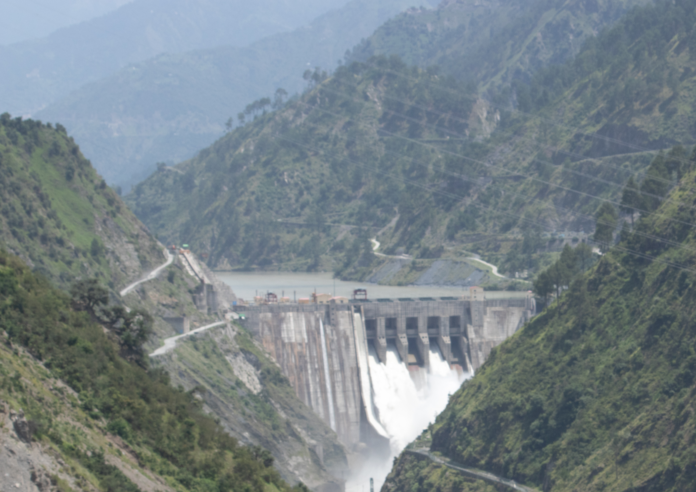The region of Occupied Kashmir, nestled in the Himalayas, is a site of geopolitical tension, escalating water-related conflicts and environmental degradation. India’s control of the region’s water, coupled with an intensified settler colonial project, has raised concerns of water apartheid and ecocide. India is pursuing several so-called ‘sustainable development projects’ in the disputed region, however, in reality, its practices are amounting to an active eco-apartheid. This is evident through its appropriation of Kashmir’s abundant hydro resources, resulting in displacement and environmental degradation that disproportionately affects the indigenous Kashmiri population.
Water & Energy Apartheid Behind Sustainable Development
Kashmir suffers from persistent and severe water and energy shortages despite the region’s plentiful water resources and hydropower potential. Under the pretext of sustainable development, India has entangled the region in water and energy apartheid. Indigenous Kashmiris are systematically deprived of water and energy resources, whilst India disproportionately benefits from the exploitation of the region’s resources. The inequality in resource allocation, driven by political, economic and geopolitical factors, continues to negatively impact the environment, as well as the indigenous communities of Kashmir.
India’s appropriation of Kashmir’s water resources is undergoing an aggressive dam construction season, supposedly aimed at generating ‘clean energy’. However, this construction spree in an ecologically fragile is posing many environmental risks, while displacing many locals. In a classic case of greenwashing, India is hiding the severe negative impacts of the development of these dams by labelling the projects as furthering sustainable development through clean energy. Ironically, despite the construction of a number of new dams, Kashmir continues to experience debilitating water shortages and prolonged electricity outages.
Occupied Kashmir currently generates around 3,263 megawatts of hydropower exceeding the region’s demand of 2,134 megawatts. Despite sufficient generation capacity, the region continues to grapple with frequent power outages. These power outages often persist for extended periods of time, particularly during harsh winters and hot summers where outages last over 4-8 hours a day.
National Hydroelectric Power Corporation Ltd. (NHCP) is a power producer owned by the Indian Occupation operating in the region and responsible for generating 60% of the region’s electricity. Despite the NHCP capitalizing on Kashmir’s water resources, it provides just 10 -13% of the electricity it produces to Kashmir, exporting the majority to India. This results in Kashmir being forced to procure the majority of its power (around 80%) from India at extortionately high prices to meet its energy requirements. This water exploitation and unequal electricity allocation emphasizes the reality of indigenous Kashmiris suffering from water and energy apartheid at the hands of the Indian Occupation.
Forced Displacements
The Indian Occupation’s dam construction in the region has resulted in the displacement of hundreds of thousands of indigenous Kashmiris. India’s relentless pursuit of hydro resources includes plans for the construction of eight new dams in this environmentally fragile region. In the district of Kishtwar located in the Chenab valley, India has begun constructing seven dams along the Chenab River all within a 50-mile radius of each other. These dams alone have resulted in the displacement of over 20,000 Kashmiris from their ancestral lands, upending lives and posing significant risk to the region’s fragile ecology.
Read More: Climate Change in Pakistan Amidst El Niño
It is worth noting that such examples are not one-off occurrences but instead have become concerningly common. The construction of the large-scale 900-megawatt Baglihar Dam in 2008, located in the Ramban district along the Chenab River, was responsible for the forced displacement of over 1,400 people. In all cases of displacement due to dam construction, the Indian government has provided inadequate compensation to the affected people, leaving them displaced without a home, land or means of sustaining themselves. Consequently, many displaced people are experiencing generational poverty, with their primary means of sustenance snatched from them.
Lack of Environmental Due Diligence
The South Asian Network on Dams, Rivers and People (SANDRP) has drawn attention to major flaws in the process of environmental impact assessment during the construction of dams in Kashmir. The group has provided evidence of India’s Ministry of Environment and Climate Change granting clearance for dam construction before such crucial assessments had been completed and without appropriately consulting affected stakeholders. This included indigenous Kashmiris whose resources, homes and land were being appropriated to facilitate dam construction while they were left in the dark. This reinforces the power imbalance between the Indian occupation and the Kashmiri population.
Read More: Climate Oppression, Eco-Apartheid & Palestinian Occupation
Despite claims that dams along the Chenab River, including the Baglihar 900 MW and Sawalkot 1,856 MW dams, are run-of-the-river schemes, experts challenge this categorization. Instead, experts have provided evidence that these dams are at high elevations, equipped with large reservoirs to store vast volumes of water and house substantial powerhouses, typical of a reservoir hydropower scheme as opposed to a run-of-the-river scheme. The disruption of natural water flow by these large dams results in significant ecological and social impacts including habitat destruction and displacement of communities. Moreover, by diverting water supplies from rivers and storing them in large reservoirs, these dams also pose challenges to the livelihoods of Kashmiris living downstream who depend on these rivers and their fisheries.
Ecological and Environmental Damage
The construction of numerous dams in Occupied Kashmir, located near each other, has unleashed severe ecological and environmental risks.
Seismic Activity
The region of Occupied Kashmir sits on a seismic belt, making it prone to frequent and intense earthquakes. Kashmir’s seismic vulnerability is exacerbated by the construction of large-scale dams on or near fault lines, where the permeation of water from dams into the fractures induces earthquakes. India’s building of dams within a mere 50-mile radius of each other along the Chenab River is a further cause for worry. This bumper-to-bumper dam construction can trigger earthquakes, endangering lives and livelihoods in the process.
Landslides and Flooding
Landslides and flooding are a common consequence of excessive large-scale dam construction. This is evident with the example of the Baglihar Dam, which has triggered frequent landslides and flooding in villages along the Chenab River.
Loss of Habitat
Excessive dam construction has altered the natural flow of rivers, putting migratory fish and other aquatic creatures at risk of extinction, and disrupting the delicate balance of the ecosystem. Birds that feed on marine life are forced to look elsewhere for food, in time disappearing from the region’s floodplains, wetlands and farmlands. GHG emissions have also increased as a result of dams.
Deforestation
India’s felling of trees to build dams has caused widespread deforestation in the region. This has led to devastating environmental impacts including a reduction in flora and fauna of the region, increased glacial melt, flash floods, and a rise in GHG emissions due to the loss of tree cover that served as carbon sinks.
Climate Justice for Kashmir
India’s damaging development projects in Occupied Kashmir are being overlooked by the international community due to its greenwashing. Such destructive development projects are ramping up under the guise of sustainable development and clean energy initiatives, raising serious concerns of water apartheid, displacement and environmental degradation. The construction of dams not only displaces indigenous communities but also disrupts fragile ecosystems and exacerbates the impacts of climate change, thus posing long-term risks to the region’s sustainability.
Recognizing the rights of indigenous Kashmiris by restoring their sovereignty over their resources through inclusive resource management and development strategies is vital to the well-being of the region. Conducting comprehensive environmental assessments for all infrastructure development projects in the region is crucial to rectifying the environmental and societal harms, while also fostering sustainable development in the region.
References
- Ahmad, O. (2016, January 16). Environmental assessment for Jammu and Kashmir dam breaks all rules. The Third Pole. https://www.thethirdpole.net/en/energy/environmental-assessment-for-jammu-and-kashmir-dam-breaks-all-rules/
- Akmali, M. (2020, November 21). Power generation in Jammu and Kashmir plummets to 408 MWs. Greater Kashmir. https://www.greaterkashmir.com/todays-paper/power-generation-in-jk-plummets-to-408-mws
- Al Jazeera. (2021, September 9). Kashmir villages facing submergence as India plans Himalayan dam. Al Jazeera. https://www.aljazeera.com/news/2021/9/9/kashmir-india-new-himalayan-dam-ujh-environment
- Environmental impacts of dams. (n.d.). International Rivers. Retrieved September 12, 2023, from https://archive.internationalrivers.org/environmental-impacts-of-dams
- India’s grand plan for Kashmir dams. (n.d.). Thediplomat.com. Retrieved September 12, 2023, from https://thediplomat.com/2022/10/indias-grand-plan-for-kashmir-dams/
- Jammu and Kashmir’s power supply to double in 3 years from 3500 MW. (n.d.). Moneycontrol. Retrieved September 12, 2023, from https://www.moneycontrol.com/europe/?url=https://www.moneycontrol.com/news/business/jammu-and-kashmirs-power-supply-to-double-in-3-years-from-3500-mw-8295651.html
- Javeed, A. (2022, April 21). Power crisis in Kashmir valley likely to worsen. Kashmir Observer. https://kashmirobserver.net/2022/04/21/power-crisis-in-kashmir-valley-likely-to-worsen/
- Kaur, H. (2019, September 10). Weaponizing Water in Kashmir. Legal Planet. https://legal-planet.org/2019/09/10/weaponizing-water-in-kashmir/
- Lateef, S. (2021, December 28). Why is Kashmir facing a power shortage? Deutsche Welle. https://www.dw.com/en/why-is-india-administered-kashmir-facing-a-power-shortage/a-60275456
- Nabi, S. (n.d.). Green power at any cost? Asparagus Magazine. Retrieved September 12, 2023, from https://www.asparagusmagazine.com/articles/new-hydro-dams-in-indian-controlled-kashmir-will-hurt-ecosystems-and-indigenous-communities
- Naik, R. H. (2020a). Climate tracker. https://climatetracker.org/construction-of-7-new-dams-in-kashmir-raises-human-environmental-cost-concerns/
- Naik, R. H. (2020b, July 24). Video: The human costs of the Baglihar dam. The Third Pole. https://www.thethirdpole.net/en/energy/video-the-human-cost-of-the-baglihar-dam/
- Naik, R. H. (2020c, October 30). Homes, nature lost for seven new dams in Kishtwar, Jammu & Kashmir. The Third Pole. https://www.thethirdpole.net/en/nature/homes-nature-lost-for-seven-new-dams-in-kishtwar-jammu-kashmir/
- Open letter to J&KSPCB: Cancel public hearings for Sawalkote HEP for violations. (2016, January 14). SANDRP. https://sandrp.in/2016/01/14/open-letter-to-jkspcb-cancel-public-hearings-for-sawalkote-hep-for-violations/
- Understanding the role of Water in India’s occupation of Kashmir. (2020, August 2). Stand With Kashmir. https://standwithkashmir.org/understanding-the-role-of-water-in-indias-occupation-of-kashmir/



